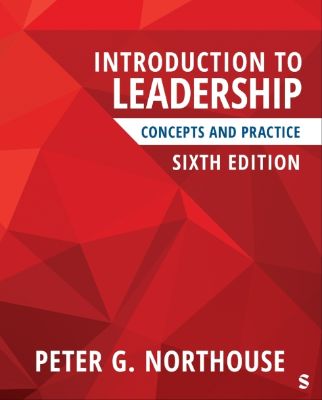
Lýsing:
Includes new chapter on Working with Groups! The Sixth Edition of Peter G. Northouse’s best-selling Introduction to Leadership : Concepts and Practice provides readers with a clear, concise overview of the complexities of practicing leadership and concrete strategies for becoming better leaders. The text is organized around key leader responsibilities such as creating a vision, engaging strengths, and managing conflict.
Case studies, self-assessment questionnaires, observational exercises, and reflection and action worksheets engage readers to apply leadership concepts to their own lives. Grounded in leadership theory and the latest research, the fully updated, highly practical Sixth Edition includes a new chapter on working with groups, 2 new cases, and 6 new Leadership Snapshots. Also available as a digital option (courseware).
Annað
- Höfundur: Peter G. Northouse
- Útgáfa:6
- Útgáfudagur: 2023-11-09
- Hægt að prenta út 2 bls.
- Hægt að afrita 2 bls.
- Format:ePub
- ISBN 13: 9781071884959
- Print ISBN: 9781071928059
- ISBN 10: 1071884956
Efnisyfirlit
- Preface
- Acknowledgments
- About the Author
- Chapter 1 Understanding Leadership
- Introduction
- Ways of Viewing Leadership
- Leadership Is a Trait
- Leadership Is an Ability
- Leadership Is a Skill
- Leadership Is a Behavior
- Leadership Is a Relationship
- Leadership Is an Influence Process
- New and Evolving Approaches to Leadership
- Leadership and Management
- Leadership and Culture
- Leadership’s “Dark Side”
- Understanding Effective Leadership
- Summary
- Key Terms
- Chapter 2 Recognizing Your Traits
- Introduction
- Leadership Traits Explained
- Intelligence
- Confidence
- Charisma
- Determination
- Sociability
- Integrity
- Leadership Traits in Practice
- Harriet Tubman (c. 1820–1913)
- Traits and Characteristics
- Winston Churchill (1874–1965)
- Traits and Characteristics
- Mother Teresa (1910–1997)
- Traits and Characteristics
- Dr. Anthony Fauci (1940– )
- Traits and Characteristics
- Oprah Winfrey (1954– )
- Traits and Characteristics
- LeBron James (1984– )
- Traits and Characteristics
- Harriet Tubman (c. 1820–1913)
- Summary
- Key Terms
- Introduction
- Leadership Philosophy Explained
- Theory X
- Assumption 1: The average person dislikes work and will avoid it if possible.
- Assumption 2: People need to be directed and controlled.
- Assumption 3: People want security, not responsibility.
- Theory Y
- Assumption 1: The average person does not inherently dislike work. Doing work is as natural as play.
- Assumption 2: People will show responsibility and self-control toward goals to which they are committed.
- Assumption 3: In the proper environment, the average person learns to accept and seek responsibility.
- Theory X
- Authoritarian Leadership Style
- Democratic Leadership Style
- Laissez-Faire Leadership Style
- Introduction
- Task and Relationship Styles Explained
- Task Style
- Relationship Style
- Task and Relationship Leadership in Practice
- Task Leadership
- Relationship Leadership
- Integrating Task and Relationship Leadership
- Summary
- Key Terms
- Introduction
- Administrative Skills Explained
- Administrative Skills in Practice
- Managing People
- Managing Resources
- Showing Technical Competence
- Administrative Skills in Practice
- Interpersonal Skills in Practice
- Being Socially Perceptive
- Showing Emotional Intelligence
- Managing Interpersonal Conflict
- Conceptual Skills in Practice
- Problem Solving
- Strategic Planning
- Creating Vision
- Introduction
- Strengths-Based Leadership Explained
- Historical Background
- Gallup
- Positive Psychology
- Identifying and Measuring Strengths
- Gallup and the CliftonStrengths Profile
- VIA Institute on Character and Inventory of Strengths
- Centre of Applied Positive Psychology and the Strengths Profile Assessment
- Historical Background
- Discovering Your Strengths
- Developing Your Strengths
- Addressing Your Weaknesses
- Recognizing and Engaging the Strengths of Others
- Fostering a Positive Strengths-Based Environment
- Introduction
- Vision Explained
- A Picture
- A Change
- Values
- A Map
- A Challenge
- Vision in Practice
- Articulating a Vision
- Implementing a Vision
- Summary
- Key Terms
- Introduction
- Groups Explained
- Types of Groups
- Task Groups
- Process Groups
- Stages of Groups
- Forming
- Storming
- Norming
- Performing
- Adjourning
- Individual Group Roles
- Group Task Roles
- Group-Building and Maintenance Roles
- Individual Roles
- Benefits of Group Work
- Types of Groups
- Groups in Practice
- Establish a Constructive Climate
- Provide Structure
- Clarify Goals
- Clarify Group Norms
- Build Cohesiveness
- Ways to Build Group Cohesion
- Promote Standards of Excellence
- Require Results
- Review Results
- Reward Results
- Address Out-Group Members
- Strategy 1: Listen to Out-Group Members
- Strategy 2: Show Empathy to Out-Group Members
- Strategy 3: Recognize the Unique Contributions of Out-Group Members
- Strategy 4: Help Out-Group Members Feel Included
- Strategy 5: Create a Special Relationship With Out-Group Members
- Strategy 6: Give Out-Group Members a Voice and Empower Them to Act
- Introduction
- Diversity and Inclusion Explained
- Diversity
- Inclusion
- Equity
- Approaches to Diversity
- Early Years—1960s and 1970s
- Era of Valuing Diversity—1980s and 1990s
- Diversity Management and Inclusion in the 21st Century—2000 to Present
- Model of Inclusive Practices
- Leader Practices That Advance Diversity and Inclusion
- 1. Feeling Safe
- 2. Feeling Involved and Engaged
- 3. Feeling Respected and Valued
- 4. Feeling Influential
- 5. Feeling Authentic and Whole
- 6. Recognizing, Attending to, and Honoring Diversity
- Barriers to Embracing Diversity and Inclusion
- Ethnocentrism
- Prejudice
- Unconscious Bias
- Stereotypes
- Privilege
- Introduction
- Conflict Explained
- Communication and Conflict
- Conflict on the Content Level
- Conflict Regarding Beliefs and Values
- Conflict Regarding Goals
- Conflict on the Relational Level
- Relational Conflict and Issues of Esteem
- Relational Conflict and Issues of Control
- Relational Conflict and Issues of Affiliation
- The Fisher and Ury Approach to Conflict
- Principle 1: Separate the People From the Problem
- Principle 2: Focus on Interests, Not Positions
- Principle 3: Invent Options for Mutual Gains
- Principle 4: Insist on Using Objective Criteria
- Communication Strategies for Conflict Resolution
- Differentiation
- Fractionation
- Face Saving
- The Kilmann and Thomas Styles of Approaching Conflict
- Avoidance
- Competition
- Accommodation
- Compromise
- Collaboration
- Introduction
- Leadership Ethics Explained
- Leadership Ethics in Practice
- The Character of the Leader
- The Actions of the Leader
- The Goals of the Leader
- The Honesty of the Leader
- The Power of the Leader
- The Values of the Leader
- Culture and Leadership Ethics
- Summary
- Key Terms
- Introduction
- Destructive Leadership Explained
- Toxic Triangle
- Destructive Leaders
- Susceptible Followers
- Conducive Environments
- Toxic Triangle
- Leaders
- Followers
- Context
UM RAFBÆKUR Á HEIMKAUP.IS
Bókahillan þín er þitt svæði og þar eru bækurnar þínar geymdar. Þú kemst í bókahilluna þína hvar og hvenær sem er í tölvu eða snjalltæki. Einfalt og þægilegt!Rafbók til eignar
Rafbók til eignar þarf að hlaða niður á þau tæki sem þú vilt nota innan eins árs frá því bókin er keypt.
Þú kemst í bækurnar hvar sem er
Þú getur nálgast allar raf(skóla)bækurnar þínar á einu augabragði, hvar og hvenær sem er í bókahillunni þinni. Engin taska, enginn kyndill og ekkert vesen (hvað þá yfirvigt).
Auðvelt að fletta og leita
Þú getur flakkað milli síðna og kafla eins og þér hentar best og farið beint í ákveðna kafla úr efnisyfirlitinu. Í leitinni finnur þú orð, kafla eða síður í einum smelli.
Glósur og yfirstrikanir
Þú getur auðkennt textabrot með mismunandi litum og skrifað glósur að vild í rafbókina. Þú getur jafnvel séð glósur og yfirstrikanir hjá bekkjarsystkinum og kennara ef þeir leyfa það. Allt á einum stað.
Hvað viltu sjá? / Þú ræður hvernig síðan lítur út
Þú lagar síðuna að þínum þörfum. Stækkaðu eða minnkaðu myndir og texta með multi-level zoom til að sjá síðuna eins og þér hentar best í þínu námi.
Fleiri góðir kostir
- Þú getur prentað síður úr bókinni (innan þeirra marka sem útgefandinn setur)
- Möguleiki á tengingu við annað stafrænt og gagnvirkt efni, svo sem myndbönd eða spurningar úr efninu
- Auðvelt að afrita og líma efni/texta fyrir t.d. heimaverkefni eða ritgerðir
- Styður tækni sem hjálpar nemendum með sjón- eða heyrnarskerðingu
- Gerð : 208
- Höfundur : 5933
- Útgáfuár : 2024
- Leyfi : 380


